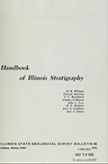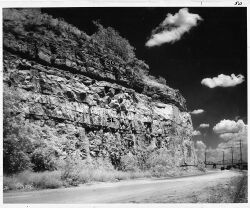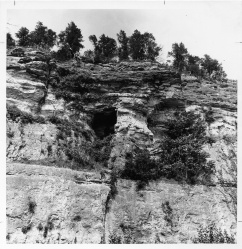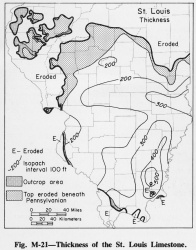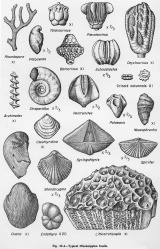Historical:St. Louis Limestone
Lithostratigraphy: Mammoth Cave Limestone Megagroup >>St. Louis Limestone
Chronostratigraphy: Paleozoic Erathem >>Mississippian Subsystem >>Valmeyeran Series
Allostratigraphy: Kaskaskia Sequence
Authors
Elwood Atherton, Charles Collinson, and Jerry A. Lineback
Name Origin
The St. Louis Limestone (Engelmann, 1847, p. 119-120; Ulrich, 1904, p. 103) is named for St. Louis, Missouri, where it is extensively exposed.
Type Section
No type section was designated for the St. Louis Limestone.
Extent and Thickness
The St. Louis is typically exposed in Illinois in the Mississippi River bluffs at Alton, Madison County (Collinson et al., 1954) (fig. M-1B). It is also well exposed in the Mississippi and Illinois Valleys in western and southern Illinois (fig. M-1D) and along the Ohio River in Hardin County (fig. M-21). The St. Louis is 500 feet thick in southeastern Illinois and thins northwestward to less than 200 feet before being truncated by pre-Pennsylvanian erosion.
Stratigraphic Position
The St. Louis overlies the Salem Limestone except in the parts of western Illinois where it lies on the Warsaw Shale or the Sonora Formation. It is overlain by the Ste. Genevieve Limestone. The lower part of that formation grades laterally into the St. Louis Limestone, and in those places the formations are separated by a vertical cut-off.
Description
The St. Louis Limestone in Illinois is characterized by fine-grained, micritic to lithographic, cherty limestone, but it contains beds of dolomite, crystalline limestone, fossiliferous limestone, and evaporites. The evaporites are represented in the outcrop areas by limestone breccias. The outcrop areas of the St. Louis are characterized by abundant sink holes.
Fossils
The rugose coral Lithostrotionella is common and characteristic (fig. M-4). In the St. Louis--Alton area the lower part of the St. Louis is included in the conodont Taphrognathus varians -- Apatognathus Zone and the upper part in the A. scalenus -- Cavusgnathus Zone. The upper St. Louis has common Eoendothyranopsis, Koninckopora pruvosti, and large archaediscids.
References
COLLINSON, CHARLES, D. H. SWANN, and H. B. WILLMAN, 1954, Guide to the structure and Paleozoic stratigraphy along the Lincoln Fold in western Illinois: Illinois State Geological Survey Guidebook Series 3, 75 p.
ENGELMANN, GEORGE, 1947, Remarks on the St. Louis Limestone: American Journal of Science, v. 3, p. 119-120.
ULRICH, E. O., 1904, in E. R. Buckley and H. A. Buehler, Quarrying industry of Missouri: Missouri Bureau of Geology And Mines, v. 2, 371 p.
ISGS Codes
| Stratigraphic Code | Geo Unit Designation |
|---|---|
